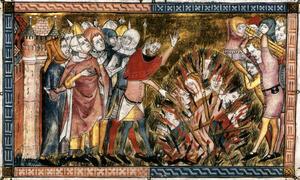Lessons from the Black Plague: Rejecting Hatred in the Face of Pandemic
In late January, I sat down to read David Nirenberg’s Communities of Violence: Persecutions of Minorities in the Middle Ages (1996), which explores the 1320 Shepherd’s Crusade and the resulting persecution of Jews in the Iberian Peninsula. Just a few months ago, fourteenth-century plagues and persecution felt very distant from the realities of twenty first-century life. But now, under the shadow of Coronavirus, Nirenberg's work feels newly relevant. In his book, Nirenberg asserts that violence in Medieval Aragon acted as a way to sow seeds of religious division within a diverse, multi-religious society. These acts of violence were often small, affecting only a few individuals at a time. But in times of hysteria, small acts can lead to massacres and even genocide.
When I first read Nirenberg's book, Coronavirus was a distant problem. The United States had only one case, and many people, myself included, did not imagine the illness would impact our day-to-day lives. How naive of us. As the disease has spread and caused frenzied behavior, I have been unable to get Nirenberg’s book out of my head. If panic incited racialized violence in the past, could panic about Coronavirus do the same now?
In 1348, internalized anti-Judaism allowed Christians to blame Jews for the Black Plague, leading to massacres. These instances of violence were the horrifying result of a belief that Jews had caused the spread of the disease. If the middle of the fourteenth century seems too far in the past to be relatable, we can turn to more recent history. For example, until recently, many Americans associated Jews—in part due to their status as immigrants—with tuberculosis outbreaks. In fact, in the globalizing world, antisemitism became increasingly associated with fear of the “other” that, to this day, affects how people view immigrants. This fear of the “other” resurfaced during the 1918 outbreak of Spanish flu, a name that the Spanish found extremely insulting (the outbreak most likely began in Kansas, not Spain). One scholar, Alan Kraut, has pointed out that on the East Coast, people began blaming Jews for spreading the 1918 flu, while on the West Coast, people largely blamed Asian immigrants.
While most Jewish people do not face the same racialized acts of violence in twenty-first century America as they did in fourteenth-century Spain, the past few election cycles have proven that antisemitism is alive and well. Most recently, a protester waved a Nazi flag at a Bernie Sanders rally. In regard to antisemitism and Coronavirus, an article in The Forward pointed out antisemitic rhetoric that appeared within days of the COVID-19 outbreak in the Western World.
That being said, Jewish people have not been the main targets of hatred during these past few weeks. As panic about the Coronavirus began to increase, so did instances of violence against Asian people. We first heard stories about Asian people receiving dirty looks in public spaces, or being avoided in crowded areas due to the racist association of the disease with China. Unfortunately, xenophobia has only increased in the weeks since. On March 1, 2020, the New York Post used a picture of an Asian man wearing a mask to announce the first confirmed Coronavirus case in Manhattan despite the fact that the diagnosed person was not Asian. In the past few weeks media outlets have documented numerous accounts of Asian-Americans being attacked, assaulted, and stabbed as they went about their day-to-day business.
These are not isolated instances. As Nirenberg suggests in his book, widespread disease creates a space for pre-existing prejudice to turn into violence. Members of our government are fueling the anti-Asian prejudice we are seeing today. Trump, among others, has publicly called COVID-19 “The Chinese Virus” and “Kung-Flu.” This rhetoric is hateful and extremely dangerous.
In the twentieth century, similar rhetoric against Jews led to the massacre of six million people. Although events leading up to the Holocaust unfolded in Europe, we should also remember that racism and xenophobia was vividly apparent in the United States during the same time period. The US government placed Japanese-Americans in concentration camps during the Second World War, just as they imprison undocumented immigrants in camps now. When we say “never again” in reference to the Holocaust, we cannot and should not only focus on the plight of Jewish people. When we say “never again,” we must mean that we will not let anything that has happened to our ancestors happen to any other marginalized group. Ever.
In the coming months, we need to be mindful of ways in which this Coronavirus pandemic will affect minorities disproportionately. It is not enough to merely refrain from using racist terms. We must be actively anti-racist by outrightly condemning hateful associations between the virus and Chinese people. The language used to refer to the pandemic is important. If you hear someone using racist language, tell them to stop. Do not let such hatred pass unnoticed.
In Judaism, we use the word “kehillah” to refer to our Jewish community and our communal obligations that are an essential part of our religion. Communal obligation encompasses the belief that our individual contributions can be assembled to benefit the future of the collective. For many of us, our community also includes neighbors, friends, and coworkers who may not be Jewish. During this scary and uncertain time, we have a duty to these people to spread love and support instead of violence. Our choices to stay home, to speak out against hatred, and to lend support to our friends and neighbors will have an impact on all of our collective futures.
My biggest takeaway from Nirenberg's Communities of Violence is that now, just as in Medieval Aragon, natural disasters and widespread tragedies often bring underlying societal biases against immigrants and minorities to the fore. We must not let them. Although we can’t physically stand closer than six feet apart right now, I urge us all to find ways to stand with our communities against scapegoating, hate, and xenophobia. We are, after all, in this together.








by any chance do you know the name of the artist of this painting? I need it for an ancient history assessment :)
This is an excellent idea, but how can we stop anti-Semitism and how can we spread love instead of hatr?
Beautifully argued; these historical lessons are all too relevant to our current crisis. Does Nuremberg give examples of Gentiles who stood against the 14th century massacres of Jews?
Thank you Savoy - great piece!